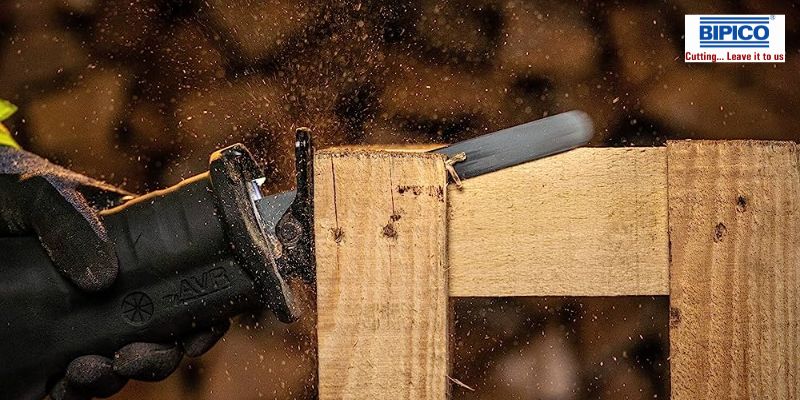A Guide to Pallet Cutting Techniques with Bimetal Reciprocating Blade
Pallets play a crucial role in safely transporting goods in the world of manufacturing and logistics. Pallet-cutting techniques are essential for efficiently handling, storing, and transporting pallets. This comprehensive guide will walk you through the various methods of pallet cutting using a bimetal reciprocating blade. Implementing these techniques can optimize your pallet management processes, improve productivity, and reduce costs.
1. Understanding Pallet Cutting
What Is Pallet Cutting?
Pallet cutting refers to the process of modifying pallets to meet specific requirements. It involves altering pallets' size, shape, or structure to accommodate different goods, optimize space utilization, or repair damaged pallets. By utilizing the right cutting techniques, you can enhance the functionality and longevity of your pallets, ultimately improving your supply chain operations.
The Importance of Pallet Cutting
- Efficient pallet cutting offers several benefits to businesses:
- Optimized Space Utilization: By resizing or reshaping pallets, you can maximize available space in warehouses, storage areas, and vehicles. This ensures efficient use of resources and reduces wasted space.
- Customization: Pallet cutting allows you to tailor pallets to fit specific products, ensuring safe and secure transportation. Customized pallets prevent damage during handling and minimize the risk of product loss.
- Improved Safety: Properly cut and maintained pallets enhance workplace safety. By removing protruding nails or splintered wood, the risk of employee injuries can be significantly reduced.
- Cost Savings: Optimized pallet-cutting techniques can help reduce material waste and minimize the need for new pallet purchases. This leads to cost savings and promotes sustainability.
Pallet Cutting Techniques
Technique 1: Pallet Resizing:
Assessment: Begin by evaluating the dimensions of the goods that need to be transported. Measure the length, width, and height to determine the required pallet size.
Marking: Use a measuring tape and marking tool to indicate the desired dimensions on the pallet. Ensure accuracy by double-checking the measurements.
Cutting: Secure the pallet on a stable surface and carefully cut the excess length, width, or height using a bimetal reciprocating blade. Ensure a smooth and clean cut for optimal results
Finishing: Smooth the cut edges using sandpaper to remove splinters or rough surfaces. This step ensures safe handling and minimizes the risk of product damage.
Technique 2: Pallet Repair
Damaged pallets can compromise the safety and efficiency of your supply chain. Pallet repair involves fixing broken boards, reinforcing weak areas, or replacing damaged components. Follow these steps to repair a pallet effectively:
Inspection: Thoroughly examine the pallet to identify any damaged or weakened sections. Look for broken boards, loose nails, or structural issues that may compromise the pallet's integrity.
Disassembly: Carefully disassemble the pallet, removing broken boards or damaged components. Use a hammer or pry bar to loosen the nails and separate the pieces.
Replacement: Replace the damaged boards with suitable replacements. Ensure they match the original dimensions and type of wood used in the pallet construction.
Reassembly: Secure the repaired boards using nails or screws, ensuring a sturdy connection. Pay attention to proper alignment and spacing between the boards.
Finishing: Smooth any rough edges or surfaces using sandpaper. This step is essential for preventing injuries during handling and maintaining product integrity.
Technique 3: Pallet Modification
Pallet modification involves altering the existing structure to enhance functionality or accommodate unique product requirements. Here are some common modifications:
Adding Dividers: By installing dividers, you can create separate sections on the pallet for organizing and transporting goods that need to be kept apart.
Integrating Wheels: Attaching wheels to pallets enables easier maneuverability, especially in areas with frequent movements, such as warehouses or distribution centers.
Implementing Safety Features: Enhance pallet safety by adding corner protectors, edge guards, or non-slip surfaces to prevent goods from shifting or falling during transportation.
Customizing Load Capacity: Reinforce pallets by adding additional support beams or crossbars to increase load-bearing capacity. This modification ensures the safe transportation of heavier or bulky items.
Conclusion
Efficient pallet-cutting techniques are instrumental in streamlining logistics operations, optimizing space utilization, and improving workplace safety. By implementing these techniques using a bimetal reciprocating blade; businesses can achieve customized pallets that meet specific requirements. Pallet resizing, repair, and modification enhance productivity, reduce costs, and improve supply chain efficiency. Embrace these techniques to stay ahead in the competitive manufacturing and logistics world.




Comments
Post a Comment